Solved Example Problems | Mathematics - Types of Sets | 9th EM Mathematics : Set Language
Chapter: 9th EM Mathematics : Set Language
Types of Sets
Types of Sets
There is a very special set of great interest: the
empty collection ! Why should one care about the empty collection? Consider the
set of solutions to the equation x2+1
= 0. It has no elements at all in the set of Real Numbers. Also consider all
rectangles with one angle greater
than 90 degrees. There is no such rectangle and hence this describes an empty
set.
So, the empty set is important, interesting and
deserves a special symbol too.
1. Empty Set or Null Set
A set consisting of no element is called the empty set or null set or void set.
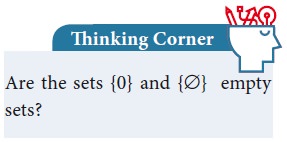
It is denoted by Ø or { }.
For example,
(i) A={x :
x is an odd integer and divisible by 2}
A={
} or Ø
(ii) The set of all integers between 1 and 2.
2. Singleton Set
A set which has only one element is called a singleton set.
For example,
(i) A = {x : 3 < x < 5, x ∈ N}
(ii) B =
The set of all even prime numbers.
3. Finite Set
A set with finite number of elements is called a finite set.
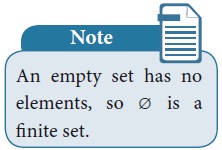
For example,
1.
The set of family members.
2.
The set of indoor/outdoor games you play.
3.
The set of curricular subjects you learn in school.
4.
A = {x :
x is a factor of 36}
4. Infinite Set
A set which is not finite is called an infinite set.
For example,
(i) {5,10,15,...}
(ii) The set of all points on a line.
To discuss further about the types of sets, we need
to know the cardinality of sets.
Cardinal number of a set :
When a set is finite, it is very useful to know
how many elements it has. The number
of elements in a set is called the Cardinal number of the set.
The cardinal number of a set A is denoted by n(A)
Example 1.3
If A = {1,2,3,4,5,7,9,11}, find n(A).
Solution
A =
{1,2,3,4,5,7,9,11}
Since set A
contains 8 elements, n(A) = 8.
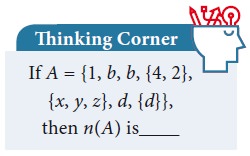
5. Equivalent Sets
Two finite sets A
and B are said to be equivalent if
they contain the same number of elements. It is written as A ≈ B.
If A and B are equivalent sets, then n(A)
= n(B)
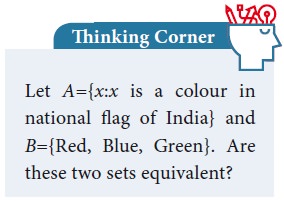
For example,
Consider A
= { ball, bat} and B = {history,
geography}.
Here A is
equivalent to B because n(A)
= n(B) = 2.
Example 1.4
Are P = { x : –3 ≤ x ≤ 0, x ∈ Z} and Q = The set of
all prime factors of 210, equivalent sets?
Solution
P = {–3,
–2, –1, 0}, The prime factors of 210 are 2,3,5,and 7 and so, Q = {2, 3, 5, 7} n(P) =4 and n(Q)
= 4. Therefore P and Q are equivalent sets.
6. Equal Sets
Two sets are said to be equal if they contain exactly the same elements, otherwise they are said to be unequal.
In other words, two sets A and B are said to be
equal, if
(i) every element of A is also an element of B
(ii) every element of B is also an element of A
For example,
Consider the sets A = {1, 2, 3, 4} and B = {4, 2, 3, 1}
Since A
and B contain exactly the same
elements, A and B are equal sets.

A set does not change, if one or more elements of
the set are repeated.
For example, if we are given
A={a,
b, c} and B={a, a,
b, b, b, c} then, we write B = { a, b, c, }. Since, every element of A is also an element of B and
every element of B is also an element
of A, the sets A and B are equal.
Example 1.5
Are A = {x : x ∈ N, 4 ≤ x ≤ 8} and
B = { 4, 5, 6, 7, 8} equal sets?
Solution
A = { 4, 5,
6, 7, 8}, B = { 4, 5, 6, 7, 8}
A and B are equal sets.
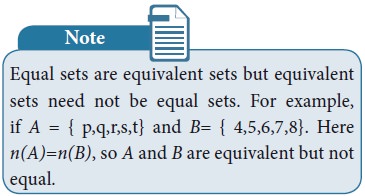
7. Subset
Let A and B be two sets. If every element of A is also an element of B, then A is called a subset of B.
We write A ⊆ B.
A ⊆
B is read as “A is a subset of B”
Thus A ⊆ B, if a ⊆ A implies a ⊆ B.
If A is not a subset of B, we write A ⊈ B
Clearly, if A is a subset of B, then n(A) ≤ n(B).
Since every element of A is also an element of B,
the set B must have at least as many
elements as A, thus n(A)
≤ n(B).
The other way is also true. Suppose that n(A)
> n(B), then A has more
elements than B, and hence there is
at least one element in A that cannot
be in B, so A is not a subset of B.
For example,
(i) {1} ⊆ {1,2,3} (ii)
{2,4} ⊈{1,2,3}
Example1.6
Write all the subsets of A = {a,
b}.
Solution
A= {a,b}
Subsets of A
are Ø,{a}, {b} and {a, b}.
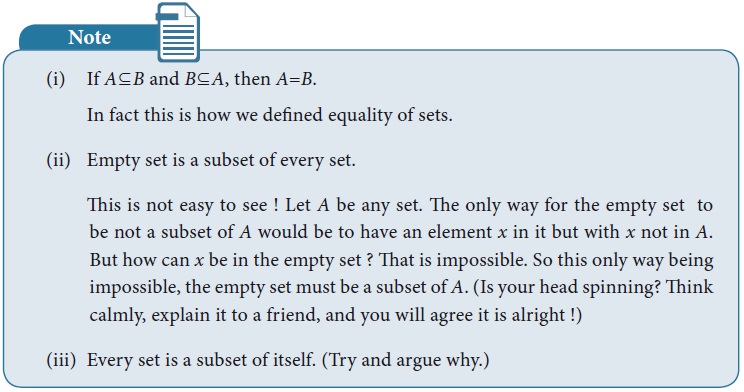
8. Proper Subset
Let A and
B be two sets. If A is a subset of B and A≠B, then A is called a proper subset of B
and we write A ⊂ B.
For example,
If A={1,2,5}
and B={1,2,3,4,5} then A is a proper subset of B ie. A ⊂ B.
Example 1.7
Insert the appropriate symbol ⊂ or ⊈ in each blank to make a true statement.
(i) {10, 20, 30} ____ {10, 20, 30,
40} (ii) {p, q,
r} _____ {w, x, y, z}
Solution
(i) {10, 20, 30} ____ {10, 20, 30, 40}
Since every
element of {10, 20, 30} is also an element of
{10, 20, 30, 40}, we get {10, 20, 30} ⊆ {10, 20, 30, 40}.
(ii) {p, q, r} _____ {w, x, y, z}
Since the
element p belongs to {p, q, r} but does not belong to
{w, x, y, z}, shows that {p, q, r} ⊈ {w, x, y, z}.
9. Power Set
The fun begins when we realise that elements of
sets can themselves be sets !
That is not very difficult to imagine: the people
in school form a set, that consists of the set of students, the set of
teachers, and the set of other staff. The set of students then has many sets as
its elements: the set of students in class 1, the set of class 2 children, and
so on. So we can easily talk of sets of sets of sets of …. of sets of elements
!
Why bother? There is a particular set of sets that
is very interesting.
Let A be
any set. Form the set consisting of all subsets of A. Let us call it B. What
all sets does B contain? For one
thing, A is inside it, since A is a subset of A. The empty set is also a subset of A, so it is in B. If x is in A, then the singleton set {x}
is in B. (This means that B has at least as many elements as A; so n(A) is equal to n(B)).
For every pair of distinct elements x,
y in A, we have {x,y} in B. So yes, B has a lot
many sets. It is so rich that it gets a very powerful name !
The set of all subsets of a set A is called the power set of ‘A’. It is denoted by P(A).
For example,
(i)
If A={2, 3}, then find the power set of A.
The subsets of A are Ø , {2},{3},{2,3}.
The power set of A,
P(A) = {Ø ,{2},{3},{2,3}}
(ii)
If A = {Ø , {Ø}}, then the power set of A is { Ø , {Ø , {Ø}}, {Ø} , {{Ø}} }.
An important property.
We already noted that n(A) ≤ n[P(A)]. But how big is P(A) ?
Think about this a bit, and see whether you come to the following conclusion:
(i) If n(A) = m, then n[P(A)] = 2m
(ii) The number of proper subsets of a set A is
n[P(A)]–1 = 2m–1.
Example 1.8
Find the number of subsets and the number
of proper subsets of a set X={a, b,
c, x, y, z}.
Solution
Given X={a,
b, c, x, y, z}.Then, n(X) =6
The number of subsets = n[P(X)] = 26 = 64
The number of proper subsets = n[P(X)]-1 = 26–1
= 64 – 1 =
63
Related Topics